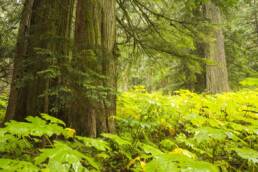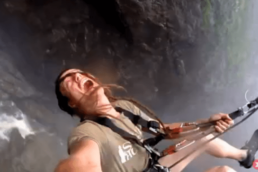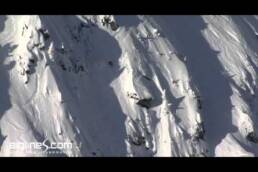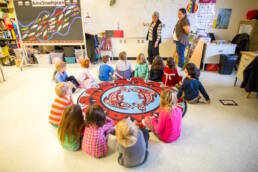The Kootenays are home to the world’s only inland temperate rainforest, and its uniqueness attracts everyone from tree huggers to tree cutters. Story by Jayme Moye. Photo by Steve Ogle.
A Kootenay old-growth forest has an unmistakable vibe. It feels moist, even in the summer, with soft, spongy moss creeping over the rocks and curtains of lichen dangling from nearly every bough. Massive cedar and hemlock trees — hundreds if not thousands of years old — stand sentry over the lush understorey, where devil’s club grows nine feet tall and grizzly bear, mountain caribou, cougar, wolf, and lynx still roam.
Scientists know this landscape as an inland temperate rainforest — and the Kootenays have the only one in the world. As the Valhalla Wilderness Society, an organization that’s been working to protect this rare ecosystem for decades, explains it, a rainforest is loosely defined as a forest that stays wet all year. In the Earth’s temperate zone — the area between the tropics and the polar regions — that typically only happens on the coast, like in British Columbia’s Great Bear Rainforest. But in the Kootenays, we have a temperate rainforest growing 400 to 600 kilometres (250 to 375 miles) from the ocean, which is why it is labelled “inland.” “Snowforest might be a better name for it,” says Eddie Petryshen, a conservation specialist at Wildsight in Kimberley, British Columbia. “Most of the moisture comes from snow, not rain.”
The North American Inland Temperate Rainforest, as it’s known, used to cover 40 million acres, forming a broad arc that blanketed the entire Kootenay region before dipping south into parts of Washington, Idaho, and Montana. Today, due to logging and development, British Columbia’s portion exists in much smaller fragments — some of which are mere remnants, especially in the southern Selkirk and Purcell Mountains, like the 2.6-kilometre (1.6-mile) out-and-back Old Growth Recreation Trail at Kokanee Glacier Provincial Park, near Nelson, British Columbia. A 2021 study titled Red-Listed Ecosystem Status of Interior Wetbelt and Inland Temperate Rainforest of British Columbia, Canada, published in Land journal, classified this rainforest as “critically endangered” and stated that ecosystem collapse is imminent in nine to 18 years if logging rates continue at current levels.
In places like Revelstoke, British Columbia, where there are still large tracts of undisturbed inland temperate rainforest, like the Argonaut and Bigmouth Valleys, residents are rallying for the clear-cutting to stop before it’s too late. “We have something really, really special here,” says Sarah Newton, a Revelstoke resident and spokesperson for Old Growth Revylution, an environmental conservation organization. “We’re the only inland temperate rainforest left in the world that’s still somewhat intact.” By late summer 2021, old-growth logging protestors in Revelstoke had swelled to 200 strong and established a full-time blockade on a logging road 120 kilometres (75 miles) north of town to protect the rainforest and beyond. Last October, forest defenders were buoyed when the provincial government announced its intention to defer logging in 2.6 million hectares of at-risk old-growth pending discussions with local Indigenous Peoples. Thirteen of the 14 cutblocks that Old Growth Revylution hoped to protect were included in that deferral. As for that last cutblock, which sits at the confluence of Argonaut and Bigmouth Creeks, Newton and her colleagues are still out there blockading. “We’re not going to budge,” she says. “It’s gotten that dire — every cutblock counts.”
Jayme Moye
Jayme Moye is an award-winning writer who specializes in stories about travel, mountain sports and culture, and pushing the limits of human potential. Her freelance work regularly appears in Outside, Canadian Geographic, National Geographic, and Condé Nast Traveler, among others. She is a Senior Writer with Kootenay Mountain Culture Magazine.
Related Stories
The Craziest Rope Swing in The World
Oh. My. God. This is absolutely terrifying. The look on their faces tells you just how terrifying it must have…
2012 Freeskiing and Freeride World Tour
2012 Freeskiing and Freeride World Tour was in Revelstoke BC on Jan 4-11. Mens Results, -Canadian Kye Petersen took…
Take Part in the Smart Kootenays Challenge
Columbia Basin communities are looking for your input on how to make the region’s coveted lifestyles even more…
Snake River Float Avalanche Airbag Save
This avalanche airbag footage was caught on January 25th, 2012 in the Snake River backcountry near Montezuma, Colo. It…
Can Words Save Our World? An In-depth Look At Indigenous Languages
Of an estimated 7,000 languages spoken around the world, only 25 of them are considered dominant. A new school of…
Alien Encounters in the Kootenays
From audio anomalies to celestial orbs, there is no shortage of Kootenay UFO sightings. Are they hallucinations?…







